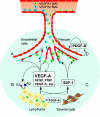Angiogenesis and antiangiogenic therapy in non-Hodgkin's lymphoma
- PMID: 19088170
- PMCID: PMC2733074
- DOI: 10.1093/annonc/mdn666
Angiogenesis and antiangiogenic therapy in non-Hodgkin's lymphoma
Abstract
Angiogenesis, the growth of new blood vessels, requires dynamic expansion, assembly and stabilization of vascular endothelial cells in response to proangiogenic stimuli. Antiangiogenic strategies have become an important therapeutic modality for solid tumors. While many aspects of postnatal pathological angiogenesis have been extensively studied in the context of nonhematopoietic neoplasms, the precise role of these processes in lymphoma pathogenesis is under active investigation. Lymphoma growth and progression is potentiated by at least two distinct angiogenic mechanisms: autocrine stimulation of tumor cells via expression of vascular endothelial growth factor (VEGF) and VEGF receptors by lymphoma cells, as well as paracrine influences of proangiogenic tumor microenvironment on both local neovascular transformation and recruitment of circulating bone marrow-derived progenitors. Lymphoma-associated infiltrating host cells including hematopoietic monocytes, T cells and mesenchymal pericytes have increasingly been associated with the pathogenesis and prognosis of lymphoma, in part providing perivascular guidance and support to neoangiogenesis. Collectively, these distinct angiogenic mechanisms appear to be important therapeutic targets in selected non-Hodgkin's lymphoma (NHL) subtypes. Understanding these pathways has led to the introduction of antiangiogenic treatment strategies into the clinic where they are currently under assessment in several ongoing studies of NHL patients.
Figures

Similar articles
-
Antiangiogenic therapies in non-Hodgkin's lymphoma.Curr Cancer Drug Targets. 2011 Nov;11(9):1030-43. doi: 10.2174/156800911798073014. Curr Cancer Drug Targets. 2011. PMID: 21933106 Review.
-
Magnitude of stromal hemangiogenesis correlates with histologic subtype of non-Hodgkin's lymphoma.Clin Cancer Res. 2006 Oct 1;12(19):5622-31. doi: 10.1158/1078-0432.CCR-06-1204. Clin Cancer Res. 2006. PMID: 17020964
-
B-cell non-Hodgkin lymphoma: importance of angiogenesis and antiangiogenic therapy.Angiogenesis. 2020 Nov;23(4):515-529. doi: 10.1007/s10456-020-09729-7. Epub 2020 May 25. Angiogenesis. 2020. PMID: 32451774 Review.
-
Targeting Angiogenesis in Cancer Therapy: Moving Beyond Vascular Endothelial Growth Factor.Oncologist. 2015 Jun;20(6):660-73. doi: 10.1634/theoncologist.2014-0465. Epub 2015 May 22. Oncologist. 2015. PMID: 26001391 Free PMC article. Review.
-
Role of VEGF/VEGFR in the pathogenesis of leukemias and as treatment targets (Review).Oncol Rep. 2012 Dec;28(6):1935-44. doi: 10.3892/or.2012.2045. Epub 2012 Sep 19. Oncol Rep. 2012. PMID: 22993103 Review.
Cited by
-
Imatinib disrupts lymphoma angiogenesis by targeting vascular pericytes.Blood. 2013 Jun 27;121(26):5192-202. doi: 10.1182/blood-2013-03-490763. Epub 2013 Apr 30. Blood. 2013. PMID: 23632889 Free PMC article.
-
A single-cell atlas of non-haematopoietic cells in human lymph nodes and lymphoma reveals a landscape of stromal remodelling.Nat Cell Biol. 2022 Apr;24(4):565-578. doi: 10.1038/s41556-022-00866-3. Epub 2022 Mar 24. Nat Cell Biol. 2022. PMID: 35332263 Free PMC article.
-
Computed tomography textural analysis for the differentiation of chronic lymphocytic leukemia and diffuse large B cell lymphoma of Richter syndrome.Eur Radiol. 2019 Dec;29(12):6911-6921. doi: 10.1007/s00330-019-06291-9. Epub 2019 Jun 24. Eur Radiol. 2019. PMID: 31236702
-
Microenvironment-centred dynamics in aggressive B-cell lymphomas.Adv Hematol. 2012;2012:138079. doi: 10.1155/2012/138079. Epub 2012 Feb 19. Adv Hematol. 2012. PMID: 22400028 Free PMC article.
-
EGF-Induced VEGF Exerts a PI3K-Dependent Positive Feedback on ERK and AKT through VEGFR2 in Hematological In Vitro Models.PLoS One. 2016 Nov 2;11(11):e0165876. doi: 10.1371/journal.pone.0165876. eCollection 2016. PLoS One. 2016. PMID: 27806094 Free PMC article.
References
-
- Carmeliet P, Jain RK. Angiogenesis in cancer and other diseases. Nature. 2000;407:249–257. - PubMed
-
- Rafii S, Lyden D, Benezra R, et al. Vascular and haematopoietic stem cells: novel targets for anti-angiogenesis therapy? Nat Rev Cancer. 2002;2:826–835. - PubMed
-
- Ferrara N. VEGF and the quest for tumour angiogenesis factors. Nat Rev Cancer. 2002;2:795–803. - PubMed
-
- Ferrara N, Gerber HP, LeCouter J. The biology of VEGF and its receptors. Nat Med. 2003;9:669–676. - PubMed
-
- Kim KJ, Li B, Winer J, et al. Inhibition of vascular endothelial growth factor-induced angiogenesis suppresses tumour growth in vivo. Nature. 1993;362:841–844. - PubMed
Publication types
MeSH terms
Substances
Grants and funding
LinkOut - more resources
Full Text Sources
Other Literature Sources

